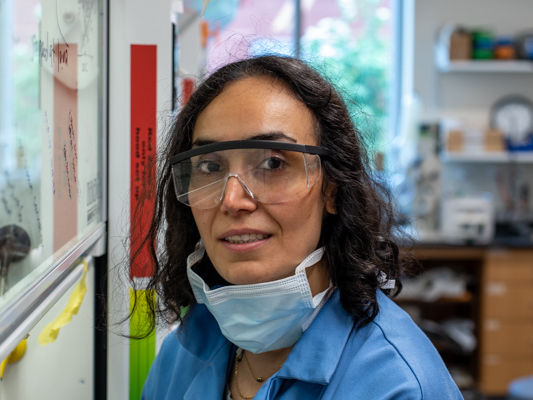Invention: "Nanocage" tool untangles (molecular) spaghetti
“Nanocage” - a tool that can catch and straighten out molecule-sized tangles of polymers
A team of scientists at the University of Vermont have invented a new tool--they call it a "nanocage"--that can catch and straighten out molecule-sized tangles of polymers.

UVM post-doc Mona Sharafi helped build a tiny tool that can untie knots of protein, plastic or other polymers.
Joshua Brown
Once a knotty polymer strand--whether made of protein or plastic--is pulled open "then we can activate just the polymers we want, while leaving the rest alone, " says UVM chemist Severin Schneebeli who led the new research. This tool--that works a bit like pulling a wad of thread through a needle hole--"opens a new way to create custom materials that have never been made before," he says. These might include nanoscale pill coatings that wrap around single molecules of medicine or new industrial products assembled from precisely arranged strands of plastic at the atomic scale.
The tool, composed of molecular edges with special "shape-directing" hydrogen bonds--and thousands of times smaller than a pinhead--can select out shorter strands of a polymer, leaving longer ones behind, demonstrating that the nanocage can be used to selectively find particular sizes of molecules in a soup of material. "It's selective and that's never been done before," Schneebeli says. This research is the first time that science has been able distinguish and activate different size polymer chains in a lab--opening the door to new possibilities for precision chemistry.
The new research was published in the June edition of the journal Chem.
NATURE KNOWS
The abilities of the nanocage are new to science--but not to nature. For billions of years, life has evolved ways to select just the bit of a protein or other biological knot that it wants to untie and turn on--what scientists call "functionalize." But people have had a hard time doing the same thing. "Despite plenty of examples in biology," the UVM scientists write, "efficient and selective modification of man-made polymers is still difficult."
Whether altering biological strands, like DNA, or industrial materials, like plastics, the new tetrahedron-shaped tool promises to let scientists do what nature already does well. "It took years of hard work in the lab to assemble this tetrahedron before we could test it," says Mona Sharafi, the lead author on the new study, and post-doctoral researcher at the Unversity of Vermont who came to the United States from Iran. "It's entirely man-made" she says, "but inspired by nature."
POTENT POLYMERS
The word polymer comes from a pair of Greek words that mean "many parts." And polymers are just that: materials made from huge molecules comprised of many repeating parts. They're found in many everyday products. Some are natural, like rubber and shellac. Many are synthetic, and are used to produce much of the material in everyday life -- from shopping bags to diapers, clothing to water pipes. Polymers can be found in tidy long strings at the molecular level--or they can be tied up in godawful knots like a billion strands of micro-spaghetti
Nature has had eons to figure out how to both synthesize these huge molecules--biopolymers, like DNA--and how to edit and activate selected portions. People have gotten pretty good at making new synthetic polymers--but not so good at selecting and editing them. Many scientists and engineers--working on new applications for renewable energy (e.g., next-generation solar cells), precision medicine (like delivery of cancer drugs to targeted parts of the body) and advanced electronics (including flexible devices)--would like to have greater control and efficiency working with what the UVM team call "functional polymers with complex topologies." With support from the National Science Foundation and the National Institutes of Health (which supported the computational studies, directed by UVM chemist Jianing Li), the research on the nanocage provides a new tool to do so-- "to untie the knot, opening polymers that would have been inaccessible before," say UVM's Mona Sharafi. "We have opened something big."






























































